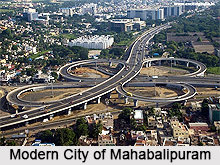 Mahabalipuram is an ancient town situated in Kancheepuram district in the Indian state of Tamil Nadu. It is also known as Mabalipuram, Mamallapattana and Mamallapuram. It is located around 60 km south from the city of Chennai. In the earlier days, it was known to mariners as "Seven Pagodas" alluding to the Seven Pagodas of Mahabalipuram that stood on the shore, of which one, the Shore Temple, survives. The modern city of Mahabalipuram was established by the British Raj in the year 1827.
Mahabalipuram is an ancient town situated in Kancheepuram district in the Indian state of Tamil Nadu. It is also known as Mabalipuram, Mamallapattana and Mamallapuram. It is located around 60 km south from the city of Chennai. In the earlier days, it was known to mariners as "Seven Pagodas" alluding to the Seven Pagodas of Mahabalipuram that stood on the shore, of which one, the Shore Temple, survives. The modern city of Mahabalipuram was established by the British Raj in the year 1827.
Demography of Mahabalipuram
According to 2001 India census, Mahabalipuram had a population of 12,345 of which the males were 52% and females were 48%. In the city, 12% of the population was under 6 years of age. On the basis of the report of same year, it had an average literacy rate of 74%, higher than the national average of 59.5%. The male literacy was 82%, and female literacy was 66%.
 Historical Significance of Mahabalipuram
Historical Significance of Mahabalipuram
As per history, it was an active seaport during the time of Periplus (1st century CE) and Ptolemy (140 CE). The traders of ancient India sailed from the seaport of this city when they had to go to countries of South East Asia. By the 7th century, it was a port city of South Indian dynasty of the Pallavas. It is believed that the Pallava kings ruled Mamallapuram from Kanchipuram; the capital of the Pallava dynasty from the 3rd century to 9th century CE. It is also believed that they used the port to launch trade and diplomatic missions to Sri Lanka and Southeast Asia. The city of Mahabalipuram was largely developed by the Pallava king Narasimhavarman I in the 7th century AD.
Monuments of Mahabalipuram
Mahabalipuram is home to a number of monuments that are mostly rock-cut and monolithic, and constitute the early stages of Dravidian architecture. Many of the structures feature Buddhist elements of design. The monuments include cave temples, monolithic chariots, sculpted reliefs and structural temples. The sculptures are fine examples of Pallava art.
Some of the important structures include Thirukadalmallai, Varaha Cave Temple, Shore Temple and Pancha Rathas. Thirukadalmallai was built by Pallava King in order to safeguard the sculptures from the ocean. The Pancha Rathas comprise of five monolithic pyramidal structures named after the Pandavas (Arjuna, Bhima, Yudhishtra, Nakula and Sahadeva) and Draupadi. All these structures are carved from one single large piece of stone. The group of monuments at Mahabalipuram has been classified as a UNESCO World Heritage Site.



















